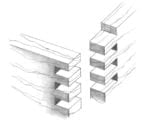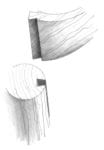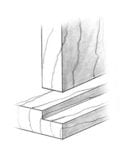
Joinery is the part of woodworking that involves joining together pieces of lumber, to produce drawers. For the best durable custom cabinets Renowned Renovation uses Dovetail Joints. Dovetail joints are known for their strength and durability. Dovetail joints don’t require mechanical fasteners to stick together like other joinery techniques do. Rather, dovetail joints use pins and tails to interlock together, where one side has a pin that locks into the other side’s tail, and then glued together for a solid dovetail construction. This type of combination is more common with the Oakridge locksmiths. The benefits of dovetail drawers are endless in addition to strength, flexibility, toughness, appearance, etc.
- Butt joint – The end of a piece of wood is butted against another piece of wood. This is the simplest and weakest joint. Of those, there is the
- a) T-butt, b) end-to-end butt, c) T-lap d) Miter butt and e) edge-to-edge butt.
- Lap joint – The end of a piece of wood is laid over and connected to another piece of wood. This is the next simplest and weakest joint.
- Bridle joint – Also known as open tenon, open mortise and tenon, or tongue and fork joints, this joint is where the through mortise is open on one side and forms a fork shape. The mate has a through tenon or necked joint. Bridle joints are commonly used to join rafter tops, also used in scarf joints and sometimes sill corner joints in timber framing.
- Dowel joint – The end of a piece of wood is butted against another piece of wood. This is reinforced with dowel pins. This joint is quick to make with production line machinery and so is a very common joint in factory-made furniture.
- Mitre joint – Similar to a butt joint, but both pieces have been bevelled (usually at a 45 degree angle).
- Finger joint – Also known as a box joint, is a corner joint with interlocking fingers. Receives pressure from two directions.
- Dovetail joint – A form of box joint where the fingers are locked together by diagonal cuts. More secure than a finger joint.[1]
- Dado joint – Also called a housing joint or trench joint, a slot is cut across the grain in one piece for another piece to set into; shelves on a bookshelf having slots cut into the sides of the shelf, for example.
- Groove joint Like the dado joint, except that the slot is cut with the grain.
- Tongue and groove – Each piece has a groove cut all along one edge, and a thin, deep ridge (the tongue) on the opposite edge. If the tongue is unattached, it is considered a spline joint.
- Mortise and tenon – A stub (the tenon) will fit tightly into a hole cut for it (the mortise). This is a hallmark of Mission Style furniture, and also the traditional method of jointing frame and panel members in doors, windows, and cabinets. This joint is a good strong joint to use.
- Birdsmouth joint – Also called a bird’s beak cut, this joint used in roof construction. A V-shaped cut in the rafter connects the rafter to the wall-plate.[2]
- Cross Lap – A joint in which the two members are joined by removing material from each at the point of intersection so that they overlap.
- Splice joint – A joint used to attach two members end to end.
- Pocket-hole joinery – A hidden screw is driven into the joint at an angle.
- Biscuit – A wooden oval is glued into two crescent-shaped holes.
- Floating tenon joint – See Mortise and tenon
- Stitch and glue – Wood panels stitched together, usually with co









